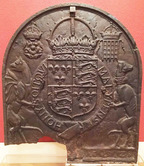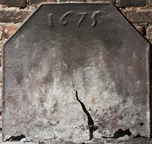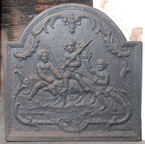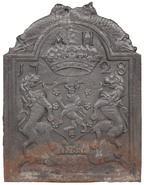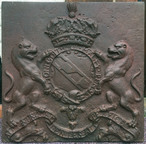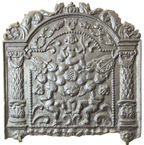-
1175
Description: Arch-shaped; fillet edge; Tudor shield, crown (with a circlet of acanthus leaves), garter (motto clockwise) and supporters. Crowned rose on dexter, and crowned portcullis (grid of 16) on sinister side of crown; the supporters, a dragon and a greyhound, stand on separate plinths; on the plinth below the greyhound is the number 28, probably half of the date 1528, the other part missing on the left side.
Notes: There are several firebacks with the Tudor royal arms that were probably produced in the Spanish Netherlands, perhaps illustrating the association between England and Spain through the marriage of Henry VIII and Katherine of Aragon. The firebacks differ in several small details, such as the form and rotation of the Garter motto, the style of the crown, the positioning of the supporters in relation to the Garter, and the form and size of the crowned rose and portcullis.
Inscription: HONY SOIT QVI MAL Y PENSE / 28
Arms: Tudor royal
- Decoration tags:
- rounded arched (shape)
- fillet (edging)
- whole carved pattern
- heraldic
- armorial
- royal
- text
Manufactured: in 1528 possibly in the Wallonia area of Luxemburg.
Current location: Consuegra, Toledo, Spain.
- Attached to series:
- Tudor royal armorial firebacks
- Continental Tudor royal armorial firebacks
-
1243
Description: Canted rectangular shape; twisted rope edging (top and sides); top centre, date '1675'.
Notes: Similar, in size, shape and position of numerals, to a fireback of 1670 but the numerals are from a different stock.
Inscription: 1675
- Decoration tags:
- rectangular with canted top corners (shape)
- rope (edging)
- carved stamps
- individual numbers
- text
Manufactured: in 1675 in England.
Current location: Harvington Hall, Chaddesley Corbett, Worcestershire, England.
(part of the Roman Catholic Archdiocese of Birmingham museum group)
- Attached to series:
- Date only firebacks
-
367
Description: Arched rectangular shape; fillet and cavetto moulded edging; pictorial scene of three children, the centre one holding a stick strung with a bunch of grapes over his shoulder, and sitting on a goat.
Notes: A mythological scene of the young Bacchus.
- Decoration tags:
- rectangular with round arch (shape)
- fillet and cavetto (edging)
- whole carved pattern
- pictorial
- mythological
- humans
Manufactured: in the 18th century in France.
Current location: Newarke Houses, Leicester, Leicestershire, England.
Museum number: H.358.1953.0.0 (part of the Leicester City Museums museum group)
Citation: Carpentier, H., 1912, Plaques de Cheminées (Paris, published by the author).
- Attached to series:
- Miscellaneous pattern firebacks
-
870
Description: Arched rectangular shape with ovolo-moulded edging and narrow extensions to sides; central shield bearing arms with lion rampant supporters and motto scroll beneath; above, a marquesal coronet; date split between top corners; inserted initials above coronet; on top of arch, two downward facing dolphins with tails entwined.
Notes: The arms are of the family of Henry Pierrepont, marquess of Dorchester and earl of Kingston-upon-Hull, of Thoresby Hall, Nottinghamshire (blazon: argent semi of cinquefoils gules, a lion rampant sable), with the motto: Pie Repone Te (Place yourself piously), a pun on the name, Pierrepont. Confusingly, the marquisate of Dorchester was created twice for members of the same family. In 1645 it was created for Henry Pierrepont, 2nd earl of Kingston-upon-Hull, becoming extinct on his death without surviving male issue in 1680. It was created again for Evelyn Pierrepont, the 5th earl of Kingston in 1706 who was subsequently elevated to the dukedom of Kingston in 1715. The original casting may therefore have dated to between 1645 and 1680 or between 1706 and 1715. The initials may be related to the Halls, the 2nd Duke of Kingston's mother's family, and were probably added with the date in 1728. Woolley & Wallis auction, Salisbury, 8 Jul 2014, lot 518 (£250); Lyon and Turnbull auction, Edinburgh, 1 Sep 2021, lot 10.
Copies of this fireback are known.
Inscription: A H / 17 28 / PIE REPONE TE
Arms: Pierrepont, Marquess of Dorchester
- Decoration tags:
- rectangular with round arch (shape)
- ovolo (edging)
- whole carved pattern
- individual letters
- armorial
- text
Manufactured: in 1728 in England.
Current location: not known.
- Attached to series:
- Personal armorial firebacks
- Pierrepont series
-
390
Description: Rectangular; plain plate with shield, supporters, ducal coronet, motto and garter of the Duke of Dorset: Quarterly, Or and gules, a bend vair.
Notes: Almost certainly the arms of Lionel Sackville KG (1688-1765), created first duke of Dorset in 1720. This particular design of fireback has been produced in a variety of sizes depending on the space around the achievement of arms
Copies of this fireback are known.
Inscription: HONI SOIT QUI MAL Y PENSE / AUT NUNQUAM TENTES, AUT PERFICE [Either do not attempt, or complete]
Arms: Lionel Sackville, 1st Duke of Dorset
- Decoration tags:
- rectangular (shape)
- none (edging)
- whole carved pattern
- armorial
- text
Manufactured: in the early-18th century in the Weald area of England.
Current location: in private hands Milford, Surrey, England.
Citation: Lloyd, N., 1925, 'Domestic Ironwork I', Architectural Review, 58, pp. 58-67.
- Attached to series:
- Dorset arms series
- Personal armorial firebacks
- Sackville firebacks
-
575
Description: Arched rectangular shape; cavetto-moulded edging; on each side a column of small overlapping leaves above a pedestal with a single acanthus leaf; issuing from the top of each column two ribbons, in figure-of-eight with grenade terminals, fly across the arch; within an arched rectangular central panel with bead edging three naked children disport about a swag of fruit, with a central pomegranate, suspended from the top of each column; one figure sits on the top, facing right, the other two hang symmetrically from below, with mirrored swirls behind them; along the base is a line of acanthus leaves; on top a sea serpent is curled on each end.
Notes: The design may have been inspired by the paintings of Jan Pauwel Gillemans the younger (1651-1704); he may have worked in London in 1675-8. Another version of the fireback (no. 591), probably by the same pattern-maker, has a slightly different design. Mitford collection, Petworth House.
Copies of this fireback are known.
- Decoration tags:
- 'Dutch' (shape)
- cavetto (edging)
- whole carved pattern
- planklines
- pictorial
- mythological
- humans
- plants
Manufactured: in the late-17th century in England.
Current location: Petworth House, Petworth, West Sussex, England.
Museum number: PET/M/66 (part of the National Trust museum group)
- Attached to series:
- Carolean 'Dutch' series
